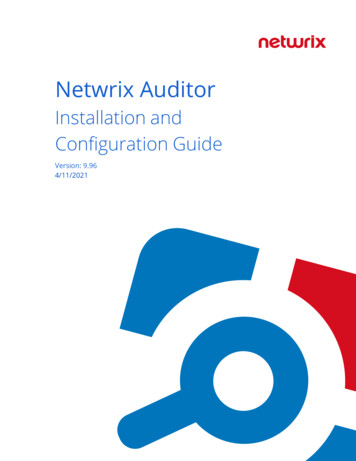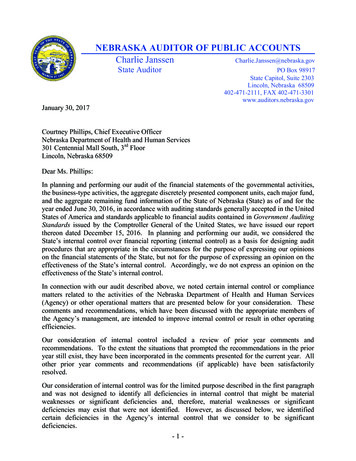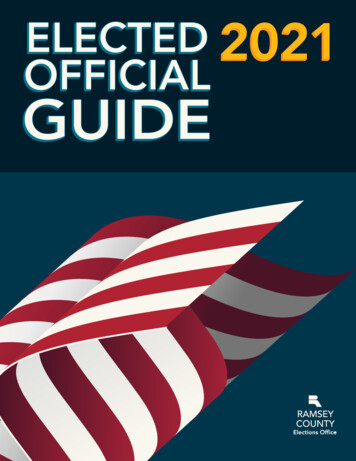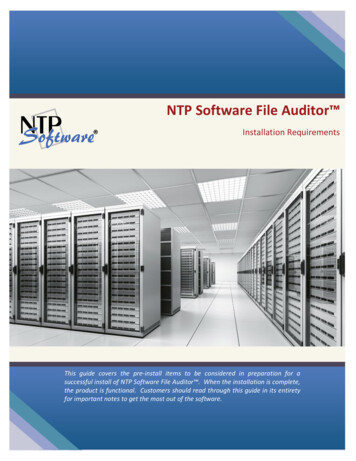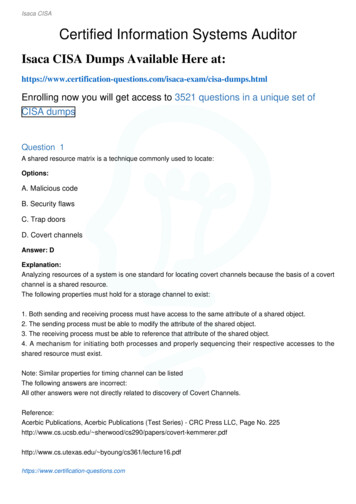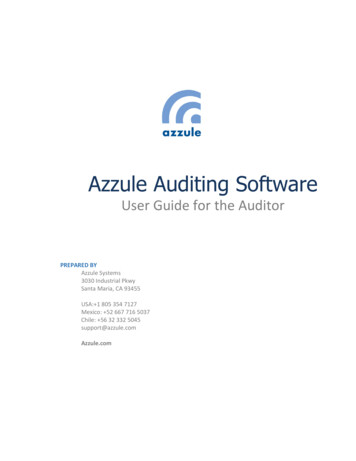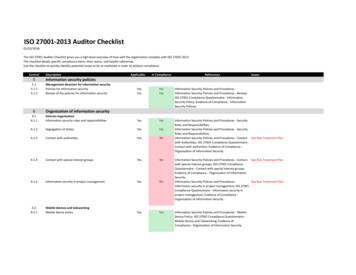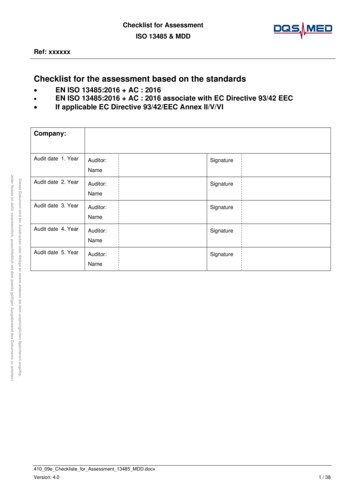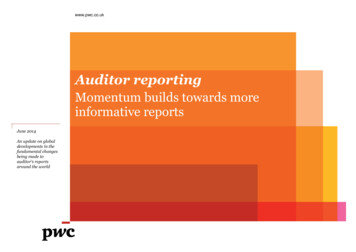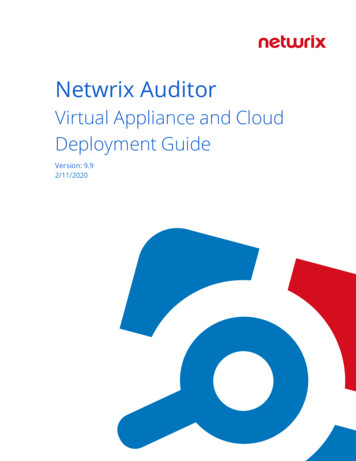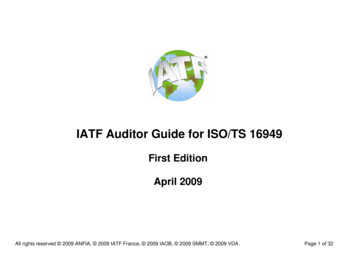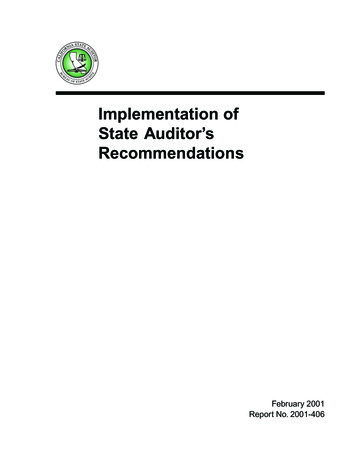
Transcription
Implementation ofState Auditor’sRecommendationsFebruary 2001Report No. 2001-406
The first five copies of each California State Auditor report are free.Additional copies are 3 each, payable by check or money order.You can obtain reports by contacting the Bureau of State Auditsat the following address:California State AuditorBureau of State Audits555 Capitol Mall, Suite 300Sacramento, California 95814(916) 445-0255 or TDD (916) 445-0255 x 216ORThis report may also be availableon the World Wide Webhttp://www.bsa.ca.gov/bsa/Alternate format reports available upon request.Permission is granted to reproduce reports.
Table of ContentsCorrective ActionIntroduction1ReportsEducationReport Number 98113, Department of Education: Lax MonitoringLed to Payment of Unsubstantiated Adult Education Claims andChanges in the Program May Seriously Impact Its Effectiveness3Report Number 98124, Perkins Vocational Education Program:The State’s Use of Funds to Administer Other Programs Reduced ItsAbility to Provide Effective Administration and Leadership7Report Number 99121, Department of Education: Its MonitoringEfforts Give Limited Assurance That It Properly Administers Stateand Federal Programs11Report Number 99123, Los Angeles Unified School District: ItsSchool Site-Selection Process Fails to Provide Information Necessaryfor Decision Making and to Effectively Engage the Community19Report Number 99130, Grant Joint Union High School District:It Needs to Improve Controls Over Operations and Measure theEffectiveness of Its Title I Program23Report Number 99131, STAR Program: Ongoing ConflictsBetween the State Board of Education and the Superintendent ofPublic Instruction as Well as Continued Errors Impede theProgram’s Success31Report Number 2000-108, Standardized Tests: Although SomeStudents May Receive Extra Time on Standardized Tests That Is NotDeserved, Others May Not Be Getting the Assistance They Need35Higher EducationReport Number 96040, California Community Colleges: TheChancellor’s Office Should Exercise Greater Oversight of the Use ofInstructional Service Agreements for Training or Services39
Report Number 2000-103, California Community Colleges: PoorOversight by the Chancellor’s Office Allows Districts to IncorrectlyReport Their Level of Spending on Instructor Salaries43Report Number 2000-107, California Community Colleges: PartTime Faculty Are Compensated Less Than Full-Time Faculty forTeaching Activities47Report Number 96041, California State University: While Its Systemof Direct Vendor Payments Should Continue, Its Credit Card ProgramCould Benefit From Better Controls49Report Number I970051, California State University, Fullerton:The California State University at Fullerton Mismanaged TrustAccounts, Contracts, and Donated Funds59Report Number 99122, California State University, Northridge:Absent University Standards and Other Guidance, the WorldPornography Conference Was Allowable Under the Basic Tenets ofAcademic Freedom and Free Speech63Report Number 99134, Los Angeles Community College District:It Has Improved Its Procedures for Selecting College Presidents67HealthReport Number 97118.2, Department of Corporations’ Regulationof Health Care Plans: Despite Recent Budget Increases,Improvements in Consumer Protection Are LimitedReport Number 97025.1, Department of Health Services: TheForensic Alcohol Program Needs to Reevaluate Its Regulatory Efforts7377Report Number 98117, Department of Health Services: Has MadeLittle Progress in Protecting California’s Children From LeadPoisoning81Report Number 99102, Department of Health Services: DespiteShortcomings in the Department’s Monitoring Efforts, Limited DataSuggest Its Two-Plan Model Does Not Adversely Affect Quality of andAccess to Health Care89Report Number 99106, Department of Health Services: Although ItHas Not Withheld Information Inappropriately, the Department ShouldMake Research Findings More Widely Available95
Report Number 2000-009, Department of Health Services: DrugTreatment Authorization Requests Continue to Increase97Report Number 2000-122, Department of Health Services: AConflict of Interest Did Not Cause the Fresno District’s InadequateOversight of Skilled Nursing Facilities101Report Number 99027, Department of Corrections: UtilizingManaged Care Practices Could Ensure More Cost-Effective andStandardized Health Care107Human ServicesReport Number 99112, Department of Developmental Services:Without Sufficient State Funding, It Cannot Furnish Optimal Services toDevelopmentally Disabled Adults115Report Number 98020, Department of Rehabilitation: The BusinessEnterprise Program for the Blind Is Financially Sound, butOpportunities for Improvement Exist119Report Number 96036, Department of Social Services: In-HomeSupportive Services: Since Recent Legislation Changes the WayCounties Will Administer the Program, the Department of SocialServices Needs to Monitor Service Delivery121Report Number 99103, Department of Social Services: ChildSupport Enforcement Program: Without Stronger Leadership,California’s Child Support Program Will Continue to Struggle125Report Number 99120, Department of Social Services: ChildProtective Services: Agencies Are Limited in Protecting Children FromAbuse by Released Inmates135Report Number 2000-102, Department of Social Services: ToEnsure Safe, Licensed Child Care Facilities, It Needs to MoreDiligently Assess Criminal Histories, Monitor Facilities, and EnforceDisciplinary Decisions139Report Number 2000-500, Department of Social Services: It StillNeeds to Improve Its Oversight of County Child Welfare Services149
InsuranceReport Number 2000-123, Department of Insurance: RecentSettlement and Enforcement Practices Raise Serious Concerns AboutIts Regulation of Insurance Companies153Local GovernmentReport Number 99110, Dymally-Alatorre Bilingual Services Act:State and Local Governments Could Do More to Address Their Clients’Needs for Bilingual Services159Report Number 99136, Kern County Economic Opportunity: PoorCommunication, Certain Lax Controls, and Deficiencies in BoardPractices Hinder Effectiveness and Could Jeopardize Program Funding165Report Number 99142, Department of Finance: The State-CountyProperty Tax Administration Program: The State and the CountiesContinue to Benefit, but the Department of Finance Needs to Improve ItsOversightReport Number 2000-126, San Diego Unified Port District: LocalGovernment, Including the San Diego Unified Port District, CanImprove Efforts to Reduce the Noise Impact Area and Address PublicDissatisfaction173177Public SafetyReport Number 99026, Department of Corrections: PoorManagement Practices Have Resulted in Excessive Personnel Costs185Report Number 99118, Wasco State Prison: Its Failure toProactively Address Problems in Critical Equipment, EmergencyProcedures, and Staff Vigilance Raises Concerns About InstitutionalSafety and Security191Report Number I2000-1, Department of Corrections: Investigationsof Improper Activities by State Employees (Allegation I960094)195Report Number I2000-2, California State Prison, San Quentin:Investigations of Improper Activities by State Employees(Allegation I990090)197
Report Number I2000-1, Office of Emergency Services:Investigations of Improper Activities by State Employees(Allegation I980041)199Report Number 2000-012, Department of Justice: It Is Beginningto Address Our Recommendations to Improve Controls Over theCalifornia Witness Protection Program203TransportationReport Number 99113, Department of Transportation: DisregardingEarly Warnings Has Caused Millions of Dollars to Be Spent CorrectingCentury Freeway Design Flaws207Report Number 99141, Department of Transportation: HasImproved Its Process for Issuing Permits for Oversize Trucks, but MoreCan Be Done211Report Number 2000-010, Department of Transportation: SeismicRetrofit Expenditures Are in Compliance With the Bond Act217Report Number 2000-127, Department of Transportation:Inadequate Strategic Planning Has Left the State Route 710 HistoricProperties Rehabilitation Project Nearly Without Funds and Less ThanHalf Finished219Utilities and CommerceReport Number 99021, California Public Utilities Commission:Most of Its Transportation Regulation Costs Were Appropriate, but ItNeeds to Better Allocate Indirect Costs225Report Number 99117.1, California Public Utilities Commission:Did Not Effectively Manage Its Contract for InvestigatingSan Francisco’s December 1998 Power Failure229Report Number 99117.2, California Public Utilities Commission:Weaknesses in Its Contracting Process Have Resulted in QuestionablePayments233Report Number 99124, San Francisco Public Utilities Commission:Its Slow Pace for Assessing Weaknesses in Its Water Delivery Systemand for Completing Capital Projects Increases the Risk of ServiceDisruptions and Water Shortages235
Veterans AffairsReport Number 99133, The County Veterans Service OfficerProgram: The Program Benefits Veterans and Their Dependents, butMeasurements of Effectiveness as Well as Administrative OversightNeed Improvement243Report Number 99139, California Department of Veterans Affairs:Changing Demographics and Limited Funding Threaten the Long-TermViability of the Cal-Vet Program While High Program Costs DrainCurrent Funding251Water, Parks, and WildlifeReport Number 2000-101, California’s Wildlife Habitat andEcosystem: The State Needs to Improve Its Land Acquisition Planningand OversightReport Number 99116, Water Replenishment District of SouthernCalifornia: Weak Policies and Poor Planning Have Led toExcessive Water Rates and Questionable Expenses257265Environmental ProtectionReport Number 2000-109, California Integrated WasteManagement Board: Limited Authority and Weak Oversight DiminishIts Ability to Protect Public Health and the Environment273Report Number 98027, Department of Toxic Substances Control:The Generator Fee Structure Is Unfair, Recycling Efforts RequireImprovement, and State and Local Agencies Need to Fully Implementthe Unified Program281Revenue and TaxationReport Number 98118.2, Franchise Tax Board: Its Revenue FromAudits Has Increased, but the Increase Did Not Result FromAdditional Time Spent Performing Audits287Report Number 98017.2, Franchise Tax Board: Its Tax SettlementProgram Remains an Important Alternative for Dispute Resolution291Report Number 98017.1, State Board of Equalization: Its TaxSettlement Program Continues to Have Merit293
Report Number 98118.1, State Board of Equalization: BudgetIncreases for Additional Auditors Have Not Increased Audit Revenuesas Much as Expected295State and Consumer ServicesReport Number I2000-2, Board of Chiropractic Examiners:Investigations of Improper Activities by State Employees(Allegation I990006)299Report Number 99138, California Public Employees’ RetirementSystem: Its Policies for Foreign Investing Are Consistent With ItsMission and With Legal Guidelines301Report Number 98115, California Science Center: The State HasRelinquished Control to the Foundation and Poorly Protected ItsInterests305Report Number 98115.1, California Science Center: It Does NotEnsure Fair and Equitable Treatment of Employees, Thus Exposing theState to Risk313Report Number I2000-1, California Science Center: Investigations ofImproper Activities by State Employees (Allegation I990031)319Report Number 2000-111, Department of Consumer Affairs:Lengthy Delays and Poor Monitoring Weaken Consumer Protection321Report Number 99500, Department of General Services: TheCalifornia Multiple Award Schedules Program Has Merit but Does NotEnsure That the State Gets the Best Value for Its Purchases325Report Number 98114, State Personnel Board: Its Management ofDisciplinary Hearings Has Improved, but Further Changes AreNecessary327Trade and CommerceReport Number 99025, California Trade and Commerce Agency:It Has Not Demonstrated Strong Leadership for the ManufacturingTechnology Program, Collected Data Necessary to Measure ProgramEffectiveness, or Ensured Compliance With Program Requirements333General GovernmentReport Number 2000-001.3, CAL-Card Program: It Has Merits,but It Has Not Reached Its Full Potential335
Report Number 99101, Office of the Attorney General: ItDiligently Investigated the Legality of Downey Community HospitalFoundation’s Transactions, but Questions Remain About SoundBusiness Practices341Report Number 99001.1, Overtime for State Employees: SomeDepartments Have Paid Too Much in Overtime Costs345Report Number I2000-2, Prison Industry Authority: Investigationsof Improper Activities by State Employees (Allegation I980123)351Report Number 2000-001.4, State of California: UnnecessaryAdministrative Fees Increase the State’s Cost of Contracting WithCalifornia State Universities355Report Number 2000-110, State-Owned Intellectual Property:Opportunities Exist for the State to Improve Administration of ItsCopyrights, Trademarks, Patents, and Trade Secrets359Report Number 2000-117, State’s Real Property Assets: The StateHas Identified Surplus Real Property, but Some of Its PropertyManagement Processes Are Ineffective365
IntroductionThis report summarizes the major findings and recommendations fromaudit and investigative reports we issued from January 2000 throughJanuary 2001. The purpose of this report is to identify what actions, ifany, these departments have taken in response to our findings andrecommendations. We have placed this symbol Ü in the left-handmargin of the summary to identify areas of concern or issues that webelieve the department has not adequately addressed.For this report, we have relied upon required periodic written responsesprepared by auditees to determine whether corrective action has beentaken. The Bureau of State Audits’ (BSA) policy requests that auditeesprovide a written response to the audit findings and recommendationsbefore the audit report is initially issued publicly. As a follow up, werequire the auditee to respond at least three times subsequently: at60 days, 6 months, and 1 year after the public release of the audit report.We may at times require follow-up beyond 1 year or have initiated afollow-up audit if deemed necessary.We report all instances of substantiated improper governmental activitiesresulting from our investigative activities to the cognizant statedepartment for corrective action. These departments are required toreport the status of their corrective actions every 30 days until all suchactions are complete.Unless otherwise noted, we have not performed any type of review orvalidation of the corrective actions reported by the auditees. Allcorrective actions noted in this report were based on responses receivedby our office as of February 7, 2001.To obtain copies of the audit and investigative reports, access the BSA’swebsite at www.bsa.ca.gov/bsa/ or contact the BSA at (916) 445-0255.1
2
Department of EducationLax Monitoring Led to Payment of UnsubstantiatedAdult Education Claims and Changes in the ProgramMay Seriously Impact Its EffectivenessReport Number 98113, July 1999Audit Highlights . . .Our review revealed that theDepartment of Educationmismanaged its oversight ofthe federal adult educationprogram. As a result,several community-basedorganizations could notsupport services for whichthey were paid.Furthermore, although it ismaking significant changesto the program, pastmonitoring problems maynot be resolved and newproblems may be created.The Joint Legislative Audit Committee requested an audit of administration of the adult education program. We focused on thedepartment’s administration of federal adult education funds andon community-based organizations’ (CBOs) use of these funds.Specifically we found:Finding #1: The department failed to detect cases where claimedservices were not substantiated.The department made payments to CBOs for more services thanthe CBOs were able to substantiate. Eight of the 10 CBOs wereviewed could not adequately document claimed hours ofinstruction for at least one of the last five fiscal years. In addition,none of the 10 CBOs could consistently show that the studentsfor whom hours were claimed demonstrated a gain in skill. Thesecollective circumstances indicate the department paid for servicesthat the CBOs may not have furnished. Although we found theseproblems to be widespread, the department rarely detected themduring its site visits, giving CBOs no compelling reason toimprove their record keeping.Finding #2: The department risks paying even more money forunsubstantiated claims in fiscal year 1999-2000 since its draftadult education monitoring procedures do not ensure thatclaimed services are documented, and it has not yet developeddocumentation requirements for service providers.3
To ensure that service providers maintain appropriate evidence tosupport their claims for payment, we recommended that thedepartment:Ü Establish strict guidelines for service providers to documentstudent testing and hours of instruction to deter easilyfalsified evidence. Place a high priority on developing a battery ofinterchangeable tests for measuring gains in skill to avoidfalsification of evidence or teaching to the test questions. Design monitoring procedures to test support for claimedservices, including review of attendance records, summarydocuments, and tests showing attainment of benchmarks.Department Action: Partial corrective action taken.As of July 2000, the department had not addressed ourrecommendation to establish guidelines for service providers todocument student testing and hours of instruction. But, thedepartment reported that its test provider has a process in placefor the ongoing development of appropriate tests. The departmentreported that it is exploring agreements with a school district anda community college to calibrate other tests developed by schooldistricts in collaboration with the test provider. Although its lastresponse did not address our recommendation regardingmonitoring procedures to test support for claimed services, thedepartment claimed that it performed a compliance review of allgrant recipients in the spring of 2000. However, the onlymonitoring document the department has provided us was aJuly 1999 draft that we found to be inadequate.Finding #3: The department’s oversight of adult educationfunding is flawed.The inconsistent review and approval by the department ofapplications for federal funding from CBOs raises questionsregarding the fairness of its decisions. Specifically, thedepartment approved some deficient applications while rejectingothers for the same deficiencies. In addition, it approved levels offunding for some CBOs that were unreasonable in light of theirpast performance. Further, the department awarded one grant thatwas unrealistically large given the CBO’s reported size. Inaddition, the department failed to react appropriately when itlearned of significant concerns about this same CBO.4
To ensure that its award decisions are consistent and fair, werecommended that the department: Hold all applicants accountable for submitting requiredinformation, including audit reports to qualify for funding. Evaluate funding requests in light of prior-year performanceand the size of the service provider before authorizing grantawards. Review a sample of fiscal year 1999-2000 awards to ensurethat decisions to award or deny funds are consistent anddefensible.Department Action: Partial corrective action taken.The department stated that it did not accept as eligible forfunding any application for fiscal years 2000-01 through 2002-03from an agency that did not submit required audit reports.However, it did not address whether it held applicantsaccountable for other required information. But, the departmentreported that it employed a new application-review process forfiscal years 2000-01 through 2002-03 that it believes is lesssubjective than processes used in past application reviews.Further, the department stated that it has established acomputerized database that will evaluate funding requests in lightof prior-year performance and the size of the service providerbefore authorizing grant awards. In cases where funding requestsvary significantly from past performance, the department stated itwill investigate the validity of the requests. Finally, when thedepartment reviewed fiscal year 1999-2000 awards, it foundinconsistencies in its decisions to deny three applications. It thenreevaluated those applications and subsequently approved them.Finding #4: Changes to the award process the departmentproposes may provide more consistency, but may also diminishservices.The department is implementing a new award process that mayresult in more consistent award decisions, if it follows throughwith current plans; however, a new rate structure and morestringent eligibility requirements may also reduce services for theneediest students. Additionally, because the State’s fiscal year1999-2000 budget earmarks federal funds for adult educationmuch more restrictively than the department expected, thedepartment will need to reassess its new rate structure and awardprocess.5
We recommended that the department evaluate the impact thatchanges in the program will have on students and serviceproviders. If, as we anticipate, this evaluation shows that fewerstudents will be served, the department should develop strategiesto encourage program expansion.ÜDepartment Action: None.In July 2000, the department reported that the number ofapplications it received for federal adult literacy funds hasdecreased since the institution of new federal laws requiring thedepartment to consider applicants’ performance results whenmaking awards. The department also reported that federalenrollment data indicated a decrease in the number of studentsserved in fiscal year 1998-99 and again in fiscal year 1999-2000.Although the federal government projects a slight increase forfiscal year 2000-01, the department has not provided us anystrategies to encourage program expansion.6
Perkins VocationalEducation ProgramThe State’s Use of Funds to Administer Other Programs ReducedIts Ability to Provide Effective Administration and LeadershipReport Number 98124, May 1999Audit Highlights . . .The federal governmentpassed the Carl D. PerkinsVocational and AppliedTechnology Education Act(Perkins) amendments of 1990to increase citizens’ abilitiesto compete in today’stechnologically advancedglobal society. Our reviewfound that:þ The California Departmentof Education (department)and the Chancellor’sOffice of the CaliforniaCommunity Colleges(Chancellor’s Office) usedsome Perkins funds toadminister other federaland state programs thatare similar to the Perkinsprogram.þ Since reorganizing in1995, the departmentreduced the number ofstaff working on theprogram in its SecondaryEducation Division,resulting in diminishedservices to schooldistricts.As a result, the departmentand the Chancellor’s Officehave not maximized theeffectiveness or availability ofPerkins vocational educationservices at the local level.The Joint Legislative Audit Committee requested that weevaluate the State’s administration of the Carl D. PerkinsVocational and Applied Technology Education Act (Perkins)program and determine how the California Department ofEducation’s (department) 1995 reorganization of its Curriculumand Instructional Leadership Branch affected its ability toadminister the Perkins program. We found that:Finding #1: Department employees charged Perkins funding fortime they used to administer other programs.Four of five tested employees for fiscal year 1997-98 and five offive tested employees for fiscal year 1998-99 charged nearly alltheir time to Perkins funding despite working on other state andfederal programs. In addition, the department’s RegionalOccupation Centers and Programs (ROCPs) unit charged nearlyall its administration costs to Perkins funding, even though itadministers only 17 million on Perkins funds for local projectsversus 250 million in state funds for local projects.Shifting Perkins funding to support the administrative costs ofother programs shrinks the resources available for meetingspecific Perkins goals. Moreover, since these costs are funded byother federal and state sources, they appear to be unallowable forPerkins funding.To ensure that the State meets federal cost guidelines andmandates of Perkins, we recommended that the department eitherstop using its Perkins funds to administer other federal and stateprograms or obtain approval from the federal government tosupport these programs in this way.7
ÜDepartment Action: None.The department contends that pursuant to federal law, it may usePerkins funds to improve and expand programs identified in theCalifornia State Plan. It further argues that if it stopped itscurrent method for spending Perkins dollars it would be out ofcompliance with Perkins and the federal State Plan.We have reviewed the department’s State Plan and have not seenwhere the department has informed the federal government of itsintentions to use Perkins funding for the administration of otherfederal and state programs. We continue to recommend that thedepartment obtain federal approval or discontinue using thefunding in this manner.Finding #2:The Chancellor’s Office of the CaliforniaCommunity Colleges (Chancellor’s Office) used some of itsPerkins funds to administer the State’s Economic DevelopmentProgram.From August 1977 to February 1999, the Chancellor’s Officeused over 500,000 in Perkins funds to administer the State’sEconomic Development Program. By doing so, it decreased theamount of money available to community colleges to fundservices under the Perkins program.We recommended that the Chancellor’s Office either discontinueusing Perkins funds to administer the State’s EconomicDevelopment Program or obtain prior approval from the federalgovernment to support state programs in this manner.Chancellor’s Office Action: Partial corrective action taken.The Chancellor’s Office sent a letter to the federal government inAugust 2000, asking it to determine whether the Chancellor’sOffice’s use of Perkins funds was appropriate. We have not yetseen a response from the federal government.Finding #3: As part of its reorganization, the departmentdecreased the number of staff working on the Perkins program.Despite increased administrative requirements and increasedfederal funds available for administering the program, thedepartment decreased staff working on the Perkins program inthe Secondary Education Division. As a result, administrative8
and leadership services to vocational education providersdiminished.We recommended that the department evaluate all areas where itsservices related to the Perkins program have dropped and ensurethat it maximizes the use of available Perkins funding. We alsoadvised the department to reexamine its structure in light of theresults of the statewide needs assessment to be conducted underthe 1998 Perkins Act and ensure that it is organized in a way tofully address the State’s needs.Department Action: Partial corrective action taken.The department believes vocational education services to localeducational agencies have not diminished, but have instead takenon a different focus. Further, the department believes that its1995 reorganization increased the number of services available tovocational education programs and brought it into compliancewith a federal directive to integrate vocational education withacademics. However, in response to our recommendation, thedepartment states that it has entered into an interagencyagreement that will assist in the development of the State Planand updating of its needs assessment. The department also statesthat the State Plan and needs assessment call for substantial inputfrom all of the stakeholders, and will provide the department withinformation to allow it to evaluate its ability to meet vocationaleducation needs.Contrary to the department’s assertion, our review revealedservices under the Perkins program diminished and certain schooldistricts indicate they have unmet needs. Thus, we continue tobelieve it is important that the department ensure that itmaximizes the use of available Perkins funding, and it isorganized in a way to fully address the State’s needs for thePerkins program.9
10
Department of EducationIts Monitoring Efforts Give Limited Assurance ThatIt Properly Administers State and Federal ProgramsReport Number 99121, January 2000Audit Highlights . . .Our review of the monitoringactivities revealed that theDepartment of Education(department):þ Does not focus itsmonitoring activities onhigh-risk programs andentities.þ Lacks an overall systemto track the performanceof recipients of state andfederal funds.þ Audits and InvestigationsDivision’s oversightactivities provide limitedvalue.þ Program divisions do noteffectively monitor theirrespective programs.We were asked to determine whether the Department ofEducation’s (department) Audits and Investigations Division(audits division) is structured appropriately to audit and monitorthe more than 26 billion in state and federal programs thedepartment administers. We found:Finding #1: The department needs to reevaluate its currentapproach to monitoring nonprofits and school districts.The department’s underlying philosophy focuses on ensuring thatit distributes state and federal funds to nonprofit organizationsand school districts and provides them with technical assistance.While this philosophy is well intended, it comes at the expense ofensuring that these entities meet program requirements anddiminishes the department’s ability to effectively monitor stateand federal funds.Furthermore, the department’s consideration of risk is minimalwhen planning its monitoring activities.Although thedepartment reviews program recipients every three to five yearsas required under state and federal law, it does not conduct morefrequent reviews of organizations with significant instances ofnon
Report Number 2000-107, California Community Colleges: Part-Time Faculty Are Compensated Less Than Full-Time Faculty for Teaching Activities 47 Report Number 96041, California State University: While Its System . Board of Chiropractic Examiners: Investigations of Improper Activities by State Employees (Allegation I990006) 299 Report Number .
